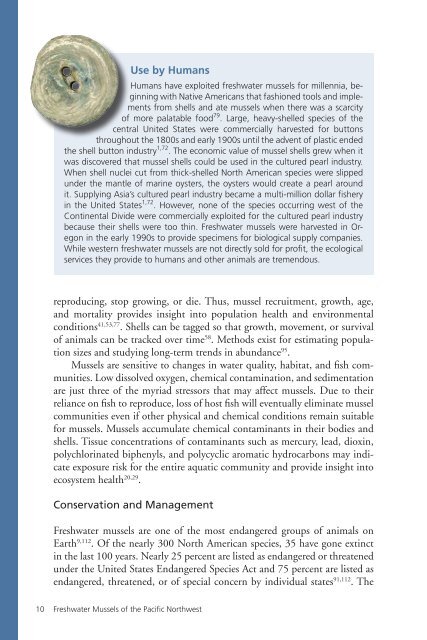Freshwater Mussels Pacific Northwest - The Xerces Society
Freshwater Mussels Pacific Northwest - The Xerces Society
Freshwater Mussels Pacific Northwest - The Xerces Society
Create successful ePaper yourself
Turn your PDF publications into a flip-book with our unique Google optimized e-Paper software.
10<br />
Use by Humans<br />
Humans have exploited freshwater mussels for millennia, beginning<br />
with Native Americans that fashioned tools and implements<br />
from shells and ate mussels when there was a scarcity<br />
of more palatable food 79 . Large, heavy-shelled species of the<br />
central United States were commercially harvested for buttons<br />
throughout the 1800s and early 1900s until the advent of plastic ended<br />
the shell button industry 1,72 . <strong>The</strong> economic value of mussel shells grew when it<br />
was discovered that mussel shells could be used in the cultured pearl industry.<br />
When shell nuclei cut from thick-shelled North American species were slipped<br />
under the mantle of marine oysters, the oysters would create a pearl around<br />
it. Supplying Asia’s cultured pearl industry became a multi-million dollar fishery<br />
in the United States 1,72 . However, none of the species occurring west of the<br />
Continental Divide were commercially exploited for the cultured pearl industry<br />
because their shells were too thin. <strong>Freshwater</strong> mussels were harvested in Oregon<br />
in the early 1990s to provide specimens for biological supply companies.<br />
While western freshwater mussels are not directly sold for profit, the ecological<br />
services they provide to humans and other animals are tremendous.<br />
reproducing, stop growing, or die. Thus, mussel recruitment, growth, age,<br />
and mortality provides insight into population health and environmental<br />
conditions 41,53,77 . Shells can be tagged so that growth, movement, or survival<br />
of animals can be tracked over time 58 . Methods exist for estimating population<br />
sizes and studying long-term trends in abundance 95 .<br />
<strong>Mussels</strong> are sensitive to changes in water quality, habitat, and fish communities.<br />
Low dissolved oxygen, chemical contamination, and sedimentation<br />
are just three of the myriad stressors that may affect mussels. Due to their<br />
reliance on fish to reproduce, loss of host fish will eventually eliminate mussel<br />
communities even if other physical and chemical conditions remain suitable<br />
for mussels. <strong>Mussels</strong> accumulate chemical contaminants in their bodies and<br />
shells. Tissue concentrations of contaminants such as mercury, lead, dioxin,<br />
polychlorinated biphenyls, and polycyclic aromatic hydrocarbons may indicate<br />
exposure risk for the entire aquatic community and provide insight into<br />
ecosystem health 20,29 .<br />
Conservation and Management<br />
<strong>Freshwater</strong> mussels are one of the most endangered groups of animals on<br />
Earth 9,112 . Of the nearly 300 North American species, 35 have gone extinct<br />
in the last 100 years. Nearly 25 percent are listed as endangered or threatened<br />
under the United States Endangered Species Act and 75 percent are listed as<br />
endangered, threatened, or of special concern by individual states 91,112 . <strong>The</strong><br />
<strong>Freshwater</strong> <strong>Mussels</strong> of the <strong>Pacific</strong> <strong>Northwest</strong>

















